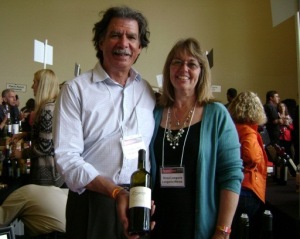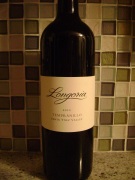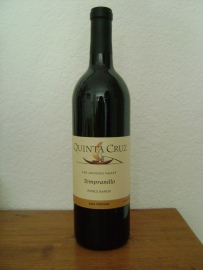Spanish Tempranillos are huge, complex wines that are known for their big tannins; noticeable oak; aromas of intense red meat, leather and tobacco; flavors of deep black fruit, herbs and spices; and even a bitter vegetal character. These are the characteristics I experienced tasting a torrent of Tempranillo at TAPAS last weekend, an annual grand tasting sponsored by Tempranillo Advocates and Producers Amigos Society, which celebrates this black-skinned monster of a variety. The biggest varietals seemed to come from four Arizona producers who make wines from grapes grown in the Sonoita AVA, an American Viticultural Area in southeast Arizona

Eight wines welcome me at the first of two seminars at TAPAS, which was held at the Presidio in San Francisco, June 23. The topic was, “Arizona? Growing Spanish Varieties in the American Southwest.” (Photo by Cynthia Bournellis)
I have to say, the six reds I tasted that morning during a seminar on Arizona wines had two things in common: tenacious tannin and loads of holiday spice—so much so that my entire palate tingled after each taste for what seemed liked minutes on end. And, the 2009 Aguileon from Dos Cabezas WineWorks made my teeth ache, even if for a moment. The Aguileon is a blend of 90 percent Tempranillo and small percentages of Petit Verdot and two Portuguese red varieties: Souzão (a grape that gets is pigment from the pulp) and Tinta Cao. Even the two whites I tasted—100 percent Malvasia from Arizona Stronghold and a Malvasia-Chardonnay blend from Caduceus Cellars—were scintillatingly spicy and intense.
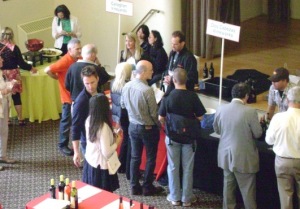
(From left to right) Arizona wineries Callaghan Vineyards and Dos Cabezas WineWorks pour to curious TAPAS-goers. (Photo by Cynthia Bournellis)
The 2007 Padres Tempranillo, Petit Verdot and Cabernet Franc blend from Callaghan Vineyards sparked aromas of celery and flavors of coffee and dark chocolate; while the 2010 Sancha Tempranillo-Grenache blend from Caduceus released palate-ripping tannins and tobacco aroma followed by dark berry flavors.
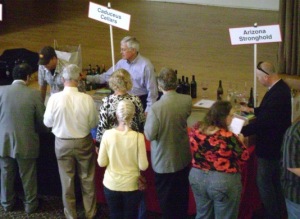
(From left to right) Arizona wineries Caduceus Cellars and Arizona Stronghold pour to curious TAPAS-goers. (Photo by Cynthia Bournellis)
Tempranillo is a huge wine that benefits from barrel aging. It can have serious tannin and good acidity, as long as yields aren’t too high. Good acid I can deal with; overbearing tannins I cannot—at least not initially. If the wine has cellaring potential, then I have no trouble waiting for it to mature. Yet, sometimes I want a Tempranillo that is drinkable now and can be enjoyed without food—one with soft tannins, a silky mouthfeel, juicy fruit and mild spice flavors, a subtle gamey aroma (nothing that reeks of red meat), hints of floral and coffee and just enough oak that complements, not overpowers, the wine. Now you might be thinking, “This doesn’t sound like your typical Spanish Tempranillo.” You are right. However, I did discover some lovely, approachable Tempranillos during my TAPAS excursion.
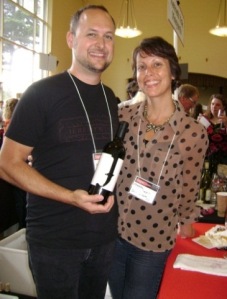
Jeremy Trettevik (winemaker) and his wife/business partner Choral Trettevik co-own Jeremy Wine Company in Lodi, California. (Photo by Cynthia Bournellis)
Jeremy Wine Company’s 2010 Tempranillo has a rich nose of fresh plum and blackberry, with an air of smokiness. Bright plum jam and firm, round tannins expand on the palate, giving way to a light, subtle chocolaty finish.
The 2010 Santa Ynez Valley Tempranillo from Longoria Wines, in Los Olivos, California, is sophistication in a bottle. Silky from start to finish, this lower-alcohol Tempranillo (13.6 percent) has deep berry and black cherry flavors, balanced acidity and a hint of licorice. This wine is definitely worth keeping for a special occasion.
The 2010 Tempranillo from Quinta Cruz, in Santa Cruz, California is similar to those of Portugal’s Douro region, where the grape is widely grown and is referred to as Tinta Roriz. The 2010 is soft on tannin and has deep blackberry and wild strawberry fruit, with hints of vanilla and anise. This wine goes with a variety of foods. An all-around crowd pleaser, the 2010 is a steal ($18). Consider it your high-end “table wine.”
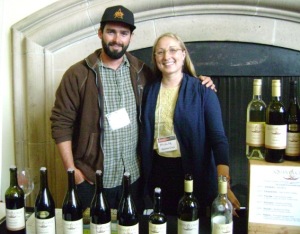
Quinta Cruz staff Ken Swegles, assistant winemaker, and Michele Bojanowski, office manager, pour a variety of white and red Iberian-style varietals. (Photo by Cynthia Bournellis)
Produced by Yorba Wines, the 2008 Tempranillo from Shake Ridge Vineyards in California’s Amador County is a home run. The palate is juicy with blackberry, dark chocolate and aromas of baking spice, followed by firm, soft tannins and a lingering chocolaty finish.
For a change of pace—and to cleanse my palate after a full day of intense reds—I tried the 2010 Estate Tempranillo Rosé from Matchbook Wines in Dunnigan Hills, Zamora, California. The Estate Rosé is a blend of Tempranillo, Syrah and Malbec grown in the winery’s Matchbook Vineyard. Stone fruit aromas of nectarine and apricot meld with flavors of white peach, crisp honeydew and cream soda.

Lane Giguiere, owner of Matchbook Wine, offers a splash of both the Tempranillo Estate Rosé and the 2009 Dunnigan Hills Tempranillo. (Photo by Cynthia Bournellis)
Tempranillo Tidbits
The second seminar of the morning, “Defining American Tempranillo,” was kicked off by Markus Bokisch, winemaker and co-owner of Bokisch Vineyards in Lodi, California. Bokisch, who has Spanish heritage, bottled his first Tempranillo in 1991. He and his wife/business partner Liz Bokisch brought back cuttings of Graciano, Tempranillo and Albariño from Spain and planted them in 1999.
More about Tempranillo:
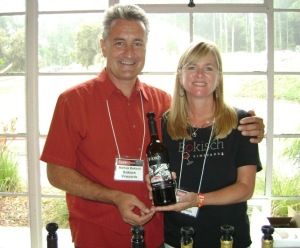
Winemaker Markus Bokisch and his wife Liz Bokisch own and operator Bokisch Vineyards in Lodi, California. (Photo by Cynthia Bournellis)
- Spain has roughly 2.4 million acres of grapes, of which 22 percent is Tempranillo (Markus Bokisch).
- Tempranillo is in 56 of 72 DOCs (Denominación de Origen Calificada or Qualified Appellation of Origin) in Spain and goes by 66 approved synonyms in the country alone (Markus Bokisch).
- Native to northern Spain, Tempranillo is widely cultivated in two regions: Rioja (north-central Spain) and Ribera del Duero (a bit farther to the south). The grape is the major component of the typical Rioja blend, which also comprises Garnacha and Graciano. Tempranillo also constitutes a major portion of Ribera del Duero wines.
- According to a 2012 article in Wines from Spain, Tempranillo’s parents are Albillo Mayor (white variety) and Benedicto (red variety), and may have been born roughly 1,000 years ago in the valley of the river Ebro, in the current regions of La Rioja and Aragón.
- Compared with Spain, Argentina has 27,000 acres of Tempranillo; France has 5,000 acres. The United States, on the other hand, has roughly 1,400 hundred acres of Tempranillo in 15 states, with 1,000 acres being cultivated in California (Markus Bokisch).·


